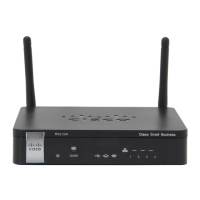Configuring Virtual Private Networks (VPNs) and Security
SSL VPN Server
Cisco RV220W Administration Guide 130
6
STEP 1 Optionally, in the Query section, choose which policies to display in the SSL VPN
Policies table.
• View List of SSL VPN Policies for—Choose Global for all users, Group for
a particular group, or User for a particular user.
• Available Groups: If you chose Group as the query type, choose a group
from this list.
• Available Users: If you chose User as the query type, choose a name from
this list.
• Click Display to run the query.
STEP 2 In the SSL VPN Policies Table, perform these tasks:
• To add a layout, click Add. Then enter the settings on the SSL VPN Policy
Configuration page. See Configuring an SSL VPN Policy, page 130.
Note: Before you can add a policy that applies to a network resource, you
must first add the resource on the VPN > SSL VPN Server > Resources
page. See Configuring a Resource, page 132.
• To edit a layout, check the box and then click Edit. Then enter the settings on
the SSL VPN Policy Configuration page. See Configuring an SSL VPN
Policy, page 130.
• To delete a layout, check the box and then click Delete. To select all layouts,
check the box in the heading row, and then click Delete. When the
confirmation message appears, click OK to continue with the deletion, or
otherwise click Cancel.
Configuring an SSL VPN Policy
Use the SSL VPN Policy Configuration page to add or edit a VPN policy.
To open this page: From the VPN > SSL VPN Server > SSL VPN Policies page,
click Add or select a policy and then click Edit.
STEP 1 In the Policy For section, enter this information:
• Policy For—Choose the type of policy: Global, Group, or User.
• Available Groups—If you choose Group, also choose the group from the list.
• Available Users—If you choose User, also choose the user from the list.

